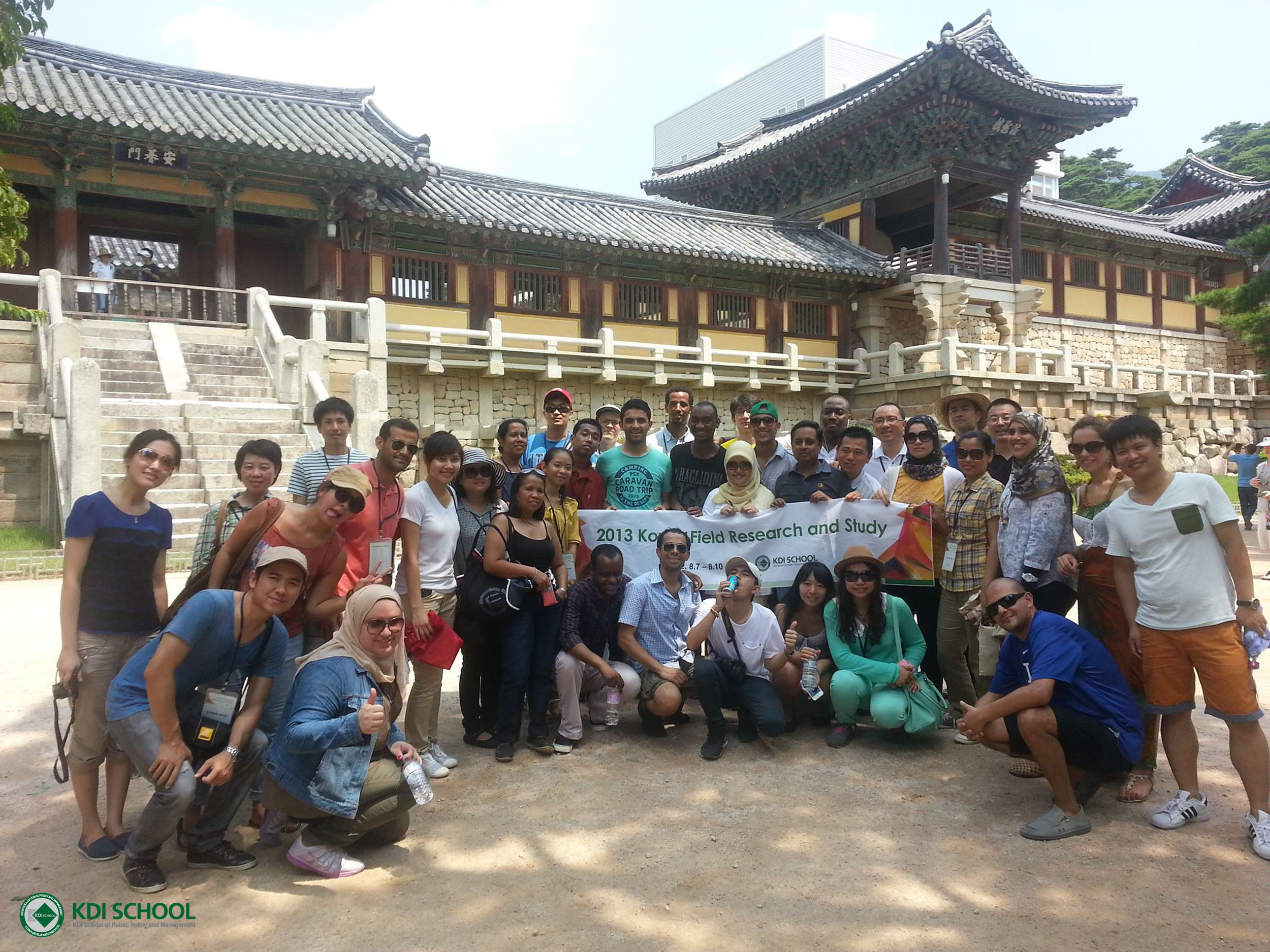
2013 Korean Field Research and Study Tour ? a diary
- Date 2013-12-01 02:03
- CategoryNews
- Hit1906
 The Korean Field Research and Study trip which ran from August 6- August 9, 2013 afforded international students of the KDI School the opportunity to learn about the story of Korea from past to present. A miraculous and yet intriguing story was laid bare for international students in words and action.
The Korean Field Research and Study trip which ran from August 6- August 9, 2013 afforded international students of the KDI School the opportunity to learn about the story of Korea from past to present. A miraculous and yet intriguing story was laid bare for international students in words and action.
 First destination was the city of Asan – popular for housing one of the largest Hyundai Motors plants and the famous Onyang Folk Museum as well as the Sudeoksa Temple. The museum is a preservatory of the traditional folk culture of Korea where traditional goods that range from crude agricultural implements, old clothing and lifestyle to religious and cultural practices are preserved for future generations. It is an amazing reservoir of a diverse and rich cultural heritage of the country dating long centuries back.
First destination was the city of Asan – popular for housing one of the largest Hyundai Motors plants and the famous Onyang Folk Museum as well as the Sudeoksa Temple. The museum is a preservatory of the traditional folk culture of Korea where traditional goods that range from crude agricultural implements, old clothing and lifestyle to religious and cultural practices are preserved for future generations. It is an amazing reservoir of a diverse and rich cultural heritage of the country dating long centuries back.
The Hyundai Motor Company is reported to be South Korea''s largest automaker and the world''s 5th largest automaker since 2007. The participants got first-hand experience of how cars are manufactured (from steel pressing to build body parts, painting and assembling). One fascinating feature of the Asan plant was the entirely self contained, independent automobile production complex which produces over 260,000 passenger vehicles annually.
In the evening, participants experienced temple stay at the treasured Sudeoksa temple located in Deoksungsan Mountain. It houses many cultural treasures such as the 3-storey stone pagoda. The participants got the opportunity to learn and appreciate the story of Buddha, the Monks and the essence of meditation for mind and body revitalization.
 The trip continued to the administrative office of the Chungnam Provincial Office, in the Chungcheongnam-do province. Chungnam is regarded as South Korea''s most prosperous province and fastest growing region in the country. With 8 cities and 8counties, the province boasts of coal, gold and silver mines, and natural minerals including a large expanse of land for agriculture and marine products. It also well-known for attractive Korean festivals such as the mud festival in Boryeong City and Strawberry festival in Nonsan City.
The trip continued to the administrative office of the Chungnam Provincial Office, in the Chungcheongnam-do province. Chungnam is regarded as South Korea''s most prosperous province and fastest growing region in the country. With 8 cities and 8counties, the province boasts of coal, gold and silver mines, and natural minerals including a large expanse of land for agriculture and marine products. It also well-known for attractive Korean festivals such as the mud festival in Boryeong City and Strawberry festival in Nonsan City.
The next stop was the Baekje Cultural Land located in the Buyeo, which is known to be Korea''s largest history park, a reservoir of the history of the Baekje. This is the best place to experience the history and culture of Baekje which include the architectural beauty of the Sabi palace, the royal temple of Neungsa, the Wiryeseong fortress, tomb Gobungongwon and beautiful pagodas as well as archery.
 The programme also took the participants to POSCO, the world largest steel company located in Pohang City. We visited both the factory and the history museum of the company. At the museum we learnt about the story behind the establishment of the company, and the challenging chain of events that almost hindered the aspiration to build the factory due to lack of capital, no technology and experience. Participants at the factory were able to see the production of steel from raw materials to smelting.
The programme also took the participants to POSCO, the world largest steel company located in Pohang City. We visited both the factory and the history museum of the company. At the museum we learnt about the story behind the establishment of the company, and the challenging chain of events that almost hindered the aspiration to build the factory due to lack of capital, no technology and experience. Participants at the factory were able to see the production of steel from raw materials to smelting.
Before closing business for the day, we visited the Tumuli Park Belt, a Gyeongju Cultural Heritage housing the three groups of royal tombs. The monumental sites showed the significant development of the Buddhist and secular architecture in Korea.
 On the last day of the trip and on the way back to Seoul a short stop was made at the ruins of Bulguksa Temple, a Gyeongju Historic Area designated as a World Heritage Site by UNESCO in 2000. The temple encompasses palaces, outdoor pagodas and statuary, and other cultural artifacts left by the Silla Kingdom. The Bulguksa Temple was one of the most important Buddhist temples.
On the last day of the trip and on the way back to Seoul a short stop was made at the ruins of Bulguksa Temple, a Gyeongju Historic Area designated as a World Heritage Site by UNESCO in 2000. The temple encompasses palaces, outdoor pagodas and statuary, and other cultural artifacts left by the Silla Kingdom. The Bulguksa Temple was one of the most important Buddhist temples.

By Michael MOLELEKE (2013 MPP, Botswana)
Related News
-
Story343 days ago
KDI School Students took part in the annual Korea Field Research and Study -
News1481 days ago
KDIS Spring Events We Are Missing This Year#NASPAA #KFRS #Korean Folk #happyhour #Talent Donation #2020 Spring #Spring Semester #Class gathering
-
News1817 days ago
2019 Korea Field Research and Study (KFRS)#Research #Field Trip #KFRS #POSCO #Hyundai Motors #field research #Gyeongju #bulguksa
